My Prague: “The Slav Epic”, Mucha’s Masterpiece
One of the greatest and most important works of Czech art from the early 20th-century was on display in the Trade Fair Palace (Veletržní Palac) in Prague until 2021.
All 20 paintings of “The Slav Epic” (Slovanská epopej) by Alfons Mucha can be viewed in the Czech capital city for the first time in over 80 years. For admirers of Mucha, Art Nouveau and history, the work is easier to reach than ever before and should not be missed.
Mucha’s The Slav Epic is a series of paintings on large canvas, which he completed in 1926. The paintings tell the story and mythology of the Slav peoples, with Mucha imagining the entire work as a commemorative piece to the Czech nation. Each painting spans several metres in both height and width, and stands tall even in a spacious exhibition hall. In every painting, grand scenes and landscapes are shown in a mixture of restrained colours, important figures, and careful details.
From 2021 to 2026, “The Slav Epic” makes its home in Moravia’s Moravsky Krumlov. Beyond 2026, the paintings are supposed to return to Prague for a longer 25-year stay.
Alfons Mucha and his Legacy
Mucha was born in 1860 in the Moravian town of Ivancice, about 20 kilometres southwest of Brno. He worked as an artist in Vienna, Munich, and Paris. In Paris, he began to find success when he produced art posters commercially for advertising and for theatre productions. He is well-known for posters of French actress Sarah Bernhardt and of the “Four Seasons” series. For the 1900 World’s Fair in Paris, Mucha designed and painted the interior wall of the Bosnia-Herzogovina Pavilion. He traveled throughout the Balkans to examine the region’s history and culture, planting the seeds for his grand work.
An Epic Accompanies “The Slav Epic”
What does it mean to people and their history when they haven’t been allowed to express themselves freely? For the Czech people under external rule for centuries until the creation of an independent nation in 1918, attempts to establish the concepts of “národ” (nation) and “vlast” (home/country) and to navigate the differences in between often appeared in literature, music, and art. Among many examples is “Má vlast”, a collection of six symphonic “poems” created by Czech composer Bedřich Smetana.
Mucha developed a stronger sense of “Czech nationalism” while he was teaching and producing art in the United States in the early years of the 20th-century. He founded the Slavic Council where he met millionaire Charles R. Crane who provided financial support when work began on The Slav Epic. Mucha spent two decades completing his epic; in the intervening time, individual pieces of the work were shown in Prague, New York, and Paris.
With all the pieces gathered in a single location, The Slav Epic premiered in its entirety to the public in Prague in 1928 on the tenth anniversary of an independent Czech nation.
Mucha donated The Slav Epic to Prague on the condition that the city build an exhibition space solely to display the collection. But the Second World War put on hold further thoughts of building this space. Mucha died in 1939, and as the land was under Nazi occupation shortly afterwards, the work was under threat of being stolen or destroyed. The paintings were hidden, and by 1963, they found their way to a castle in Moravský Krumlov, near Mucha’s birthplace.
The people of Moravský Krumlov believe that The Slav Epic should remain in their town as they have kept the work safe and on display for decades. Because Mucha donated his work to their city, the people of Prague have always urged that The Slav Epic be moved back to the capital. Some have argued that as long as Prague does not have a dedicated space as stipulated by Mucha, the art should remain in Moravský Krumlov. Others have countered that the castle in Moravský Krumlov is insufficient, requiring a great deal of expensive renovation work, and that the town is difficult to reach for visitors.
“The Slav Epic” Returns to Prague
The Slav Epic returned to Prague in 2012 to the same venue where the entire collection was debuted in 1928. The present exhibition in Veletržní Palace’s Grand Hall is based upon the layout intended by Mucha to present an overall view of the history and legends of the Slavic people.
Many of the figures in several of the paintings seem to stare directly (and ominously) at the viewer, suggesting Mucha is pleading with the viewer to take notice of not only the individual painting, but also of how the given story fits within the general narrative and timeline of the epic.
The Mucha masterpiece is presently on display until the end of 2016. As no permanent space has yet been assigned in Prague, what happens next for The Slav Epic remains unclear. But given the work’s own saga, the future for The Slav Epic could amount to another “epic” in the making.
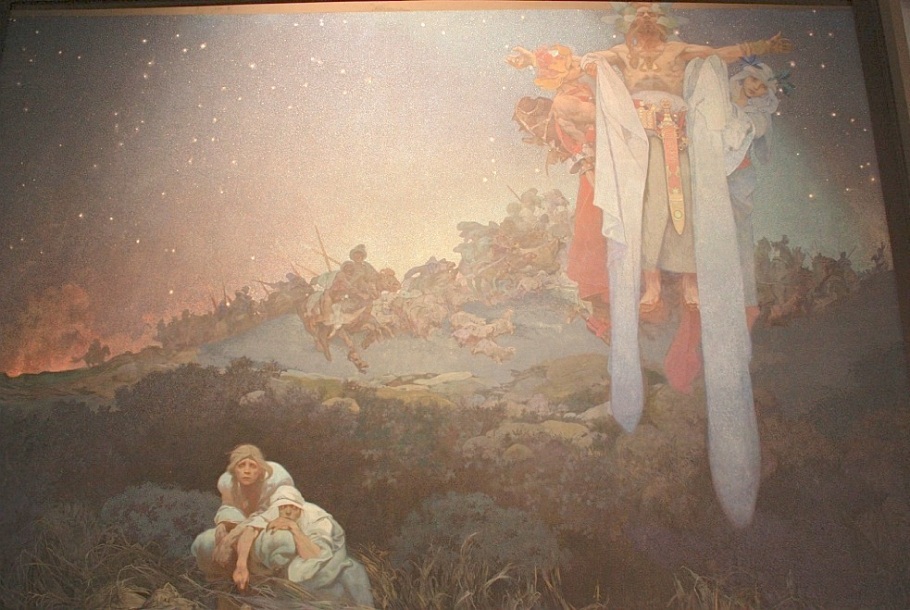
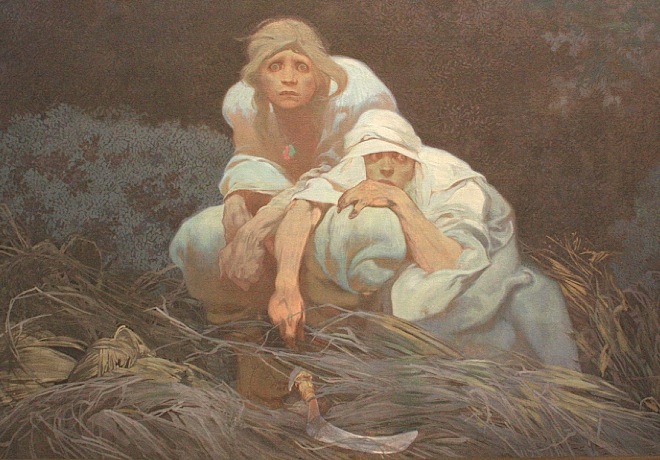
Top: No.1. The Slavs in Their Original Homeland, 1912. Below: Adam and Eve, of the Slavs.
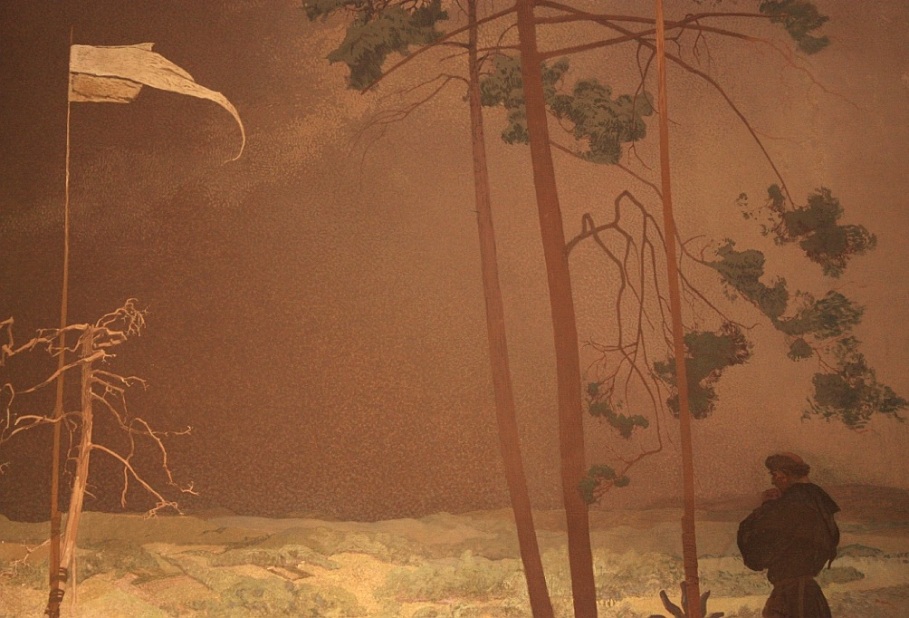
No.10. “The Meeting at Křížky”, 1916
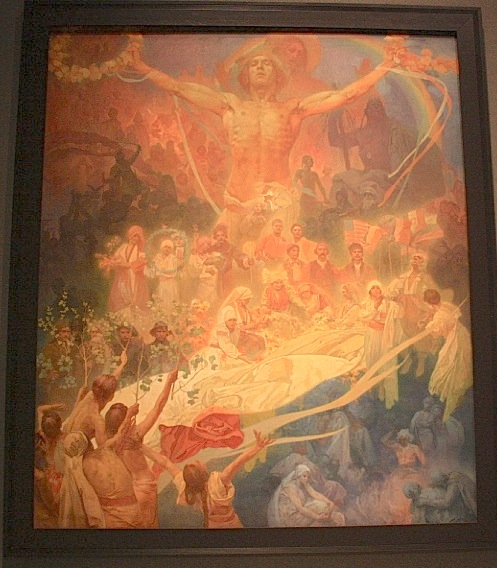
No.20. Apotheosis ‘Slavs for Humanity!’, 1926
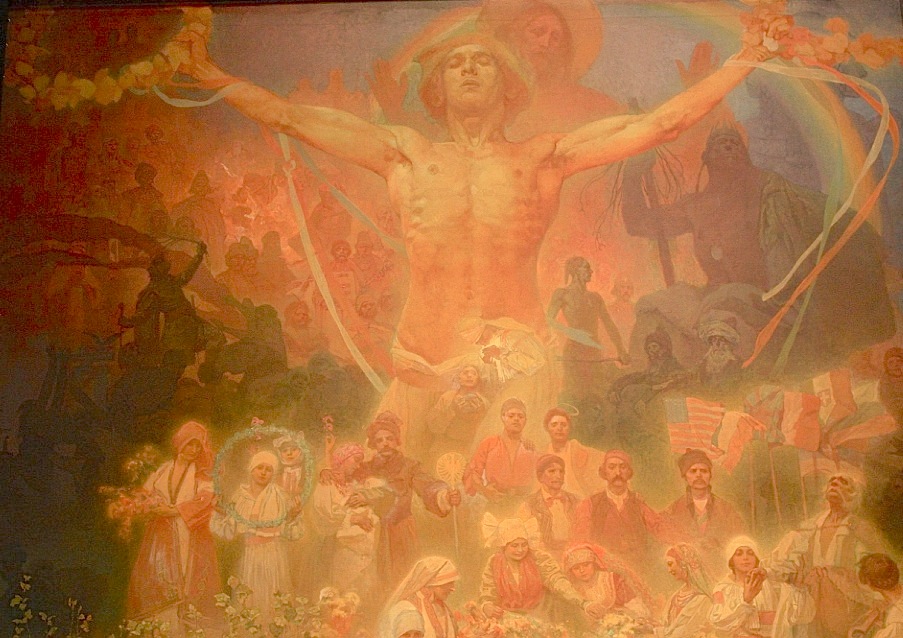
Towering Slav, wreathes of freedom and unity.
Exhibition
“The Slav Epic” exhibition was on display at Veletržní Palác (Trade Fair Palace) from December 2012 to December 2016. The fight continues about building a permanent home for The Slav Epic in Prague; the struggle is definitely real. According to a report from Czech News Agency (CTK), Michaela Vrchotova, head of public relations and marketing for the Prague City Gallery, said Mucha’s Epic might return on display in Prague in the Municipal House sometime in 2018.
Much More Mucha
• Not far from Wenceslas Square, the Mucha Museum provides a quiet place to view a wide selection of Mucha’s artistic work.
• Mucha produced the stained-glass window called ‘Allegory of the Slav Nation” appearing in St. Vitus Cathedral at Prague Castle.
• Mucha painted the murals in the Lord Mayor’s Hall in the Municipal House (Obecní dům).
• Over 120 Mucha posters in Ivan Lendl’s collection is on display at The Municipal House until 10 September 2013.
• Mucha’s final resting place is in The Slavin in the Vyšehrad cemetery.
• The Mucha Foundation
I made the photos above on 30 July and 6 August 2013. This post appears on Fotoeins Fotopress at fotoeins.com as http://wp.me/p1BIdT-3BC.
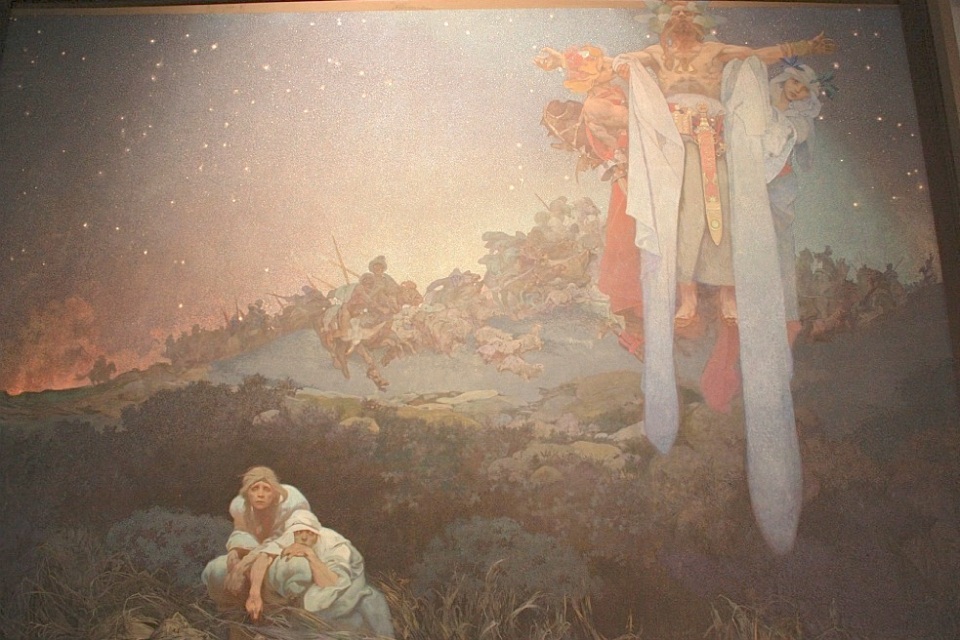
8 Responses to “My Prague: “The Slav Epic”, Mucha’s Masterpiece”
A. Mucha is my high school nightmare – we had to write about his works on our Polish language classes and match them to poems… I think that’s why I cannot appreciate his work anymore. And btw. you probably didn’t know this but his surname in my language means ‘Fly’ 🙂
LikeLiked by 1 person
Hi! I didn’t know that about his name. 🙂 I’ve learned some things about Mucha’s impact in the Czech Republic. There’s no doubt there’s a great deal of his work that’s important. Some have questioned about the true impact of his work, but no matter how varied opinions might be, there’s something about seeing a collection of early 20th-century art that’s metres high and wide in an even larger cavernous exhibition space.
LikeLike
Thanks for the announcement and pictures. We saw the show when we visited Prague in November and were blown away by the sheer size and its impact on the viewer.
LikeLiked by 1 person
Hi, Raisa. I’m so very glad to have seen “The Slav Epic”. I’d only read and see passing hints at the “grand scale” of Mucha’s grand work, and to be in Prague at the same time the “epic” was showing? I went twice within a week … and it also helps I like visiting the National Gallery at Veletržní Palace. I definitely agree: “blown away by sheer size and impact”. Do you have any favourite pieces from his masterwork? Thanks for reading and for your comment!
LikeLike
[…] • “Praha, miluju tě | I love you, Prague” • 5 of the Best Spots to View Prague at Night • “Love story number 1″ • The colours of fall in Praha • Alfons Mucha’s “The Slav Epic” Returns to Prague […]
LikeLike
[…] • 5 of the Best Spots to View Prague at Night • Na hrad! To the (Prague) castle! • “Love story number 1″ • The colours of fall in Praha • Alfons Mucha’s “The Slav Epic” Returns to Prague […]
LikeLike
[…] unique perspectives of a professional nature (above, Sarah Bernhardt) and a personal nature (below, “The Slav Epic”). I also associate Mucha with Prague, and it’s fitting the Mucha Museum prominently features […]
LikeLike
[…] unique perspectives of a professional nature (above, Sarah Bernhardt) and a personal nature (below, “The Slav Epic”). I also associate Mucha with Prague, and it’s fitting the Mucha Museum prominently features […]
LikeLike